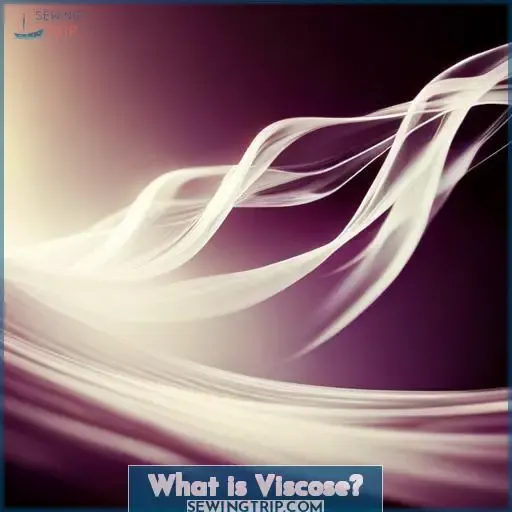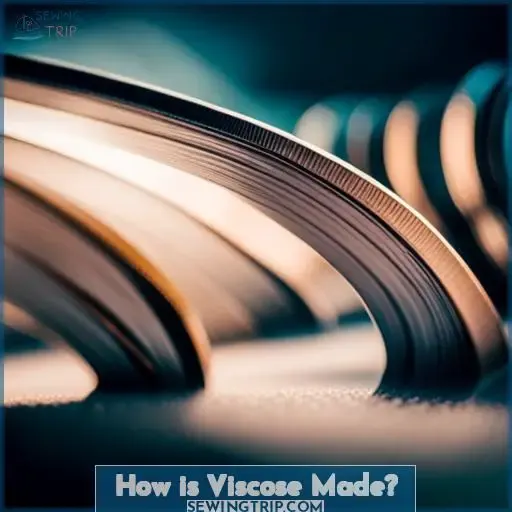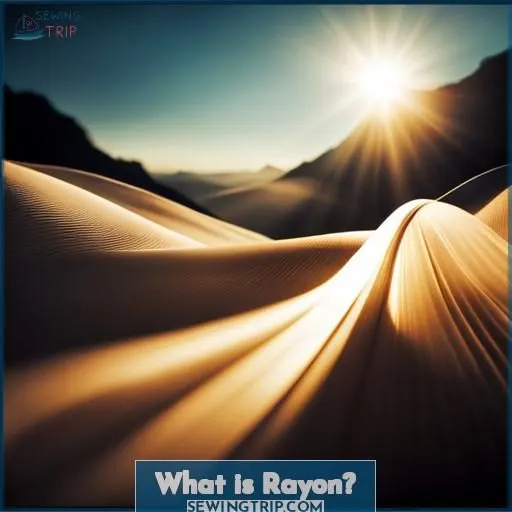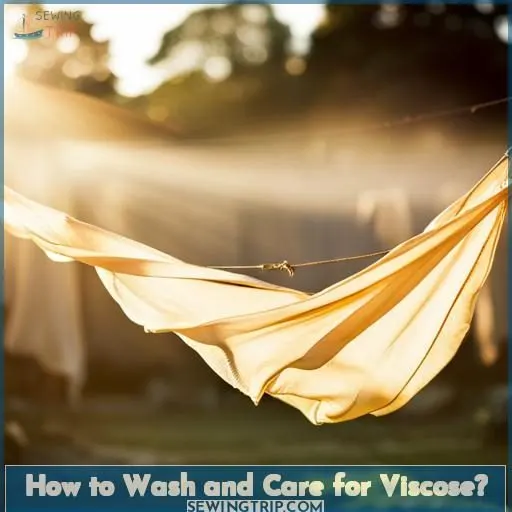This site is supported by our readers. We may earn a commission, at no cost to you, if you purchase through links.
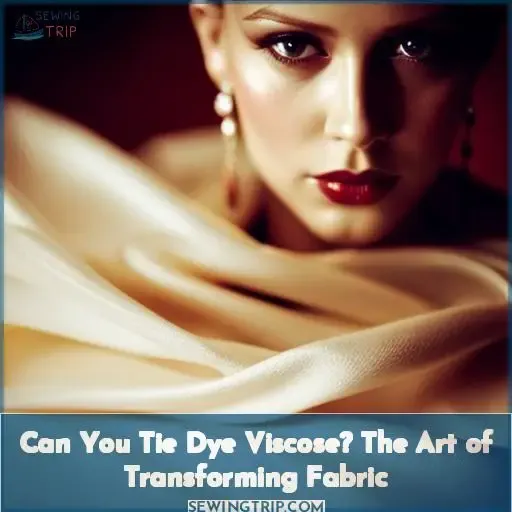 Embrace the allure of conscious fashion as you delve into the world of viscose, a fabric that holds the key to unlocking the beauty of tie-dye.
Embrace the allure of conscious fashion as you delve into the world of viscose, a fabric that holds the key to unlocking the beauty of tie-dye.
Picture yourself draped in the soft, shiny, and airy embrace of viscose and rayon fabrics – a delicate yet powerful choice that resonates with both your style and the environment.
With a heritage that traces back to the synergy of wood pulp and innovation, these fabrics exude a charm that effortlessly bridges the gap between silk and cotton, making them your go-to companions for every season.
Step into a narrative where sustainability meets sophistication, where you find liberation in your unique style choices.
Discover how viscose, also known as rayon, emerges as a versatile canvas for your creativity, ready to be adorned with vibrant tie-dye hues that weave tales of empowerment.
Unveil the secrets of caring for this delicate fabric, ensuring it remains as stunning as the day you first embraced it.
So, if you’re on a quest for mastery in both fashion and sustainability, journey with us as we unravel the intricacies of tie-dyeing viscose and rayon fabrics – a statement of elegance, a pledge to the planet.
Table Of Contents
- Key Takeaways
- What is Viscose?
- A Brief History of Viscose
- How is Viscose Made?
- Are There Better Options?
- What is Rayon?
- Can You Tie Dye Rayon?
- Can You Tie Dye Polyester?
- Can You Tie Dye Nylon?
- Can You Tie Dye Spandex?
- Can You Tie Dye Modal?
- If You Have a Project Where You Want to Tie Dye Rayon or Viscose, You Are in Luck Because Rayon (and Other Similar Fabric) is Something You Can Tie Dye, and the Colors Will Come Out Beautifully
- How to Wash and Care for Viscose?
- Why is Viscose a Better Choice?
- Frequently Asked Questions (FAQs)
- Conclusion
Key Takeaways
- Viscose fabric is derived from trees and is suitable for tie-dyeing.
- Sustainability concerns arise from the wood pulp-based production process.
- Brands like Zara and H&M have been linked to deforestation and human rights issues in relation to viscose production.
- There are eco-friendly alternatives to viscose, such as ECOVERO™, TENCEL™, and REFIBRA™.
What is Viscose?
Amid the forest of fashion choices, a seemingly eco-friendly rayon emerges, derived from trees and cloaked in a sustainable halo – but beneath that veneer lies a web of concerns about its impact on both the environment and human rights.
Viscose, also known as rayon, is a versatile textile crafted from cellulose extracted from trees like eucalyptus, bamboo, and soy. This innovative production process involves dissolving the cellulose in chemicals to create a viscous substance, which is then transformed into fibers suitable for dresses, blouses, and more.
Yet, the allure of viscose’s silky texture and seasonal versatility conceals a complex reality. Its sustainable sourcing raises eyebrows due to worries about wood pulp origins and the polluting nature of its production process, releasing toxins like carbon disulfide.
Brands like Zara and H&M have been linked to factories that contribute to deforestation and human rights abuses. As consumers desire ethical fashion, a call for responsible manufacturing practices grows stronger.
Despite these concerns, the rayon revolution pushes forward with innovations like ECOVERO™, TENCEL™, and REFIBRA™, offering more environmentally sustainable options.
In the quest for mastery over eco-conscious style, exploring alternatives such as organic cotton and upcycled fibers alongside lower-impact dyes becomes pivotal. Viscose’s allure remains undeniable, but unveiling its sustainable potential requires meticulous scrutiny and a collective commitment to reshape the fashion industry’s landscape.
A Brief History of Viscose
Explore the captivating origins of this eco-friendly fabric—venture into the fascinating history of a material that embodies sustainable fashion innovation. Hilaire’s Innovation marked the genesis of viscose, born from cellulose in trees like eucalyptus, bamboo, and soy.
It was commercially produced by the Bemberg Company in 1892. It underwent a chemical transformation—cellulose dissolved, creating a viscous substance, later spun into fibers. This process, though offering an alluring tree-based fiber, raised ethical concerns.
Sustainable sourcing of wood pulp became a focal point due to deforestation and habitat destruction, while toxic byproducts during production, like carbon disulphide, raised environmental alarms.
However, in response, the textile industry has seen an upswing in sustainable alternatives. Brands now champion responsible manufacturing with innovations like ECOVERO™, TENCEL™, and REFIBRA™. These alternatives echo the silky comfort of viscose while mitigating its ecological footprint.
As the trajectory of sustainable fashion shifts, viscose—once fraught with ethical dilemmas—undergoes a renaissance, becoming an emblem of transformative change in the realm of eco-friendly fabrics and textile innovation.
How is Viscose Made?
Dive into the heart of the process that brings about this radiant fabric’s existence: the intricate journey of turning cellulose extracted from trees into the glistening threads that form the essence of sustainable fashion.
-
Chemical Alchemy: Cellulose fibers are extracted from renewable resources like eucalyptus and bamboo. These fibers undergo a chemical dissolution, transforming them into a viscous substance, ready for the next step in the metamorphosis.
-
Eco-conscious Sourcing: Sustainability strategy is at play here. Responsible manufacturers ensure their cellulose is sourced from forests managed with eco-awareness, minimizing habitat destruction and human rights abuses.
-
Environmental Impact: The transformation from cellulose to fibers demands chemical involvement. While the process has improved, concerns linger regarding emissions and waste disposal. Brands must prioritize low-impact manufacturing techniques.
-
Fabric Transformation: The viscous solution is spun into radiant threads that capture light, forming the basis of stunning textiles. This is where the fusion of sustainable sourcing and innovative fabrication techniques shines.
-
Fabric Care: As you embrace this ethereal fabric, remember its delicacy. Gentle cleaning with cold water or a delicate machine cycle ensures its longevity. Treat it with the same mindfulness you hold for nature’s delicate balance.
In this captivating journey from tree to textile, the alchemy of cellulose transformation intertwines with sustainable strategies, yielding a fabric that radiates both beauty and responsibility.
Are There Better Options?
Discover a world of sustainable elegance as you journey through alternatives that embrace nature’s threads, weaving an eco-friendly tapestry of fashion choices.
The realm of responsible fashion offers a diverse array of plant-based fibers, each contributing to a more conscious wardrobe. Consider moisture-absorbent wonders like TENCEL™ and Modal, derived from sustainably managed forests, boasting silky textures that caress your skin.
ECOVERO™, REFIBRA™, and Eastman Naia™ emerge as innovations, marrying style with ethics.
In the realm of thread selection, aligning your values with your embroidery can make a significant impact.
| Thread Type | Visual Effect | Strength & Durability |
|---|---|---|
| Viscose | Subtle sheen, multidimensionality | Elegance and finesse |
| Polyester | Strong shine, durability | Longevity and resilience |
Upliftingly, these choices transcend aesthetics, encapsulating your journey towards a world of conscious elegance. When adorning your garments, opt for a gentle cycle, preserving fabric softness and color vibrancy.
Embrace these alternatives and practices, harmonizing with nature’s rhythm while expressing your authentic style.
What is Rayon?
Delving into the world of vibrant textile transformations, you’re about to embark on a tie-dyeing adventure that unfolds across a spectrum of fabrics. From the lustrous elegance of rayon to the resilient strength of polyester, the sheer versatility of textiles like nylon and spandex, and the eco-chic allure of modal, your creative aspirations find a canvas in these fabrics.
Whether it’s the undulating hues of rayon or the other fabric counterparts, tie-dyeing beckons as a captivating journey into color-infused style.
Can You Tie Dye Rayon?
Uncover the fascinating realm of tie-dyeing on this remarkable fabric as you delve into the world of adding vibrant colors and creative patterns to the versatile rayon material.
- Creative Techniques: Rayon’s absorbent nature allows for intricate dye patterns, from classic spirals to modern gradients.
- Vibrant Results: The dyeing process on rayon yields vivid and rich colors that complement its silk-like appearance.
- Clothing Maintenance: To preserve your tie-dyed masterpiece, opt for gentle washing with cold water and mild detergents, enhancing rayon’s longevity.
Embark on the journey of transforming this sustainable fiber into personalized works of art while championing biodegradable textiles and mastering the art of color fixation.
Can You Tie Dye Polyester?
Explore how tie-dyeing transforms polyester fabrics. Over 60% of polyester threads retain vibrant colors even after multiple dyeing and washing cycles, making it a versatile choice for creative and lasting designs.
Incorporate eco-friendly dyes and tie-dye techniques to align with sustainable fashion. Consider upcycled viscose, lower-impact dyes, and alternative materials like recycled fibers.
Can You Tie Dye Nylon?
Delving into the realm of fabric versatility, nylon, known for its durability and smoothness, becomes an intriguing canvas for tie-dye creativity. Eco-friendly dyes amplify its potential, aligning with the sustainability of viscose and contemporary fashion trends.
Whether you’re exploring Fall-Winter fashion or seeking sustainable manufacturing, tie-dyeing nylon brings a sense of empowerment and mastery.
Can You Tie Dye Spandex?
In the realm of tie-dyeing, experimenting with spandex opens up new creative dimensions. Embrace these possibilities with sustainable dyes that align with your eco-friendly fashion sense.
- Reflect on your knowledge of viscose, a cellulose-based material, as you explore spandex’s unique qualities.
- Adapt tie-dye methods to suit spandex’s stretch and resilience, embracing its versatility while maintaining patterns’ integrity.
- Extend your commitment to sustainability by using dyes that minimize environmental impact, mirroring your conscious choices in fashion.
- Draw parallels between TENCEL™ lyocell, like viscose, and explore ways its eco-friendly attributes can influence your spandex tie-dye projects.
- After tie-dyeing, maintain your vibrant creations by opting for gentle washing machine cycles and natural drying to ensure longevity.
With spandex tie-dye, your creativity merges with responsible practices, allowing you to fashionably express your liberation, power, and mastery in the world of sustainable design.
Can You Tie Dye Modal?
Discover the captivating world of tie-dyeing on Modal fabric, where vibrant colors meld seamlessly with its luxurious texture. Unleash your creativity with sustainable techniques and eco-friendly dyes, achieving colorfast results.
If You Have a Project Where You Want to Tie Dye Rayon or Viscose, You Are in Luck Because Rayon (and Other Similar Fabric) is Something You Can Tie Dye, and the Colors Will Come Out Beautifully
Explore the vibrant world of tie-dyeing with rayon and its counterparts, and witness the stunning array of colors that emerge in this creative process.
Try different tie-dye techniques like spiral or crumple for unique patterns.
Experiment with color combination ideas to create bold and eye-catching designs.
Find DIY tie-dye tutorials online for step-by-step instructions on achieving vibrant colors.
Before starting, make sure to properly prepare your viscose fabric by washing it to remove any sizing or chemicals.
So go ahead, unleash your creativity and dive into the captivating art of tie-dyeing. With rayon and other similar fabrics, you’ll be able to achieve beautiful results that will leave a lasting impression.
How to Wash and Care for Viscose?
Embrace the delicate nature of this remarkable fabric by giving your viscose garments the care they deserve. To ensure your clothing reflects both your style and values, here are essential tips for sustainable handling and maintenance:
-
Gentle Washing: Turn your garment inside out and opt for a cold or lukewarm water hand wash. Alternatively, use a machine on a delicate cycle with a wash bag to shield the fabric.
-
Air Dry with Caution: Lay your viscose pieces flat to air dry. Avoid excessive wringing to prevent stretching or misshaping. When ironing, do so on the reverse side while the fabric is still damp.
-
Matte or Silky Finish: Depending on your preferences, embrace the natural qualities of viscose—its subtle sheen for an elegant touch or its matte finish for an understated look.
-
Longevity Matters: Extend the life of your viscose clothing by reducing washing frequency. Opt for spot cleaning when possible and choose eco-friendly detergents.
-
Conscious Choices: Consider supporting labor rights and sustainability by exploring second-hand viscose garments. Your choices contribute to a more ethical fashion landscape.
Empower yourself by treating your viscose garments with care and respect, aligning fashion with values while ensuring longevity and style in harmony.
Why is Viscose a Better Choice?
Delve into the realm of sustainable fashion by considering why opting for this eco-friendly material could be the smarter choice. With its sustainable attributes stemming from wood pulp, viscose, also known as rayon, holds the potential to revolutionize the fashion industry’s environmental impact.
As concerns deepen over fast fashion’s repercussions, embracing viscose aligns with the growing shift towards ethical manufacturing.
The innovative use of wood pulp offers a renewable alternative, steering away from traditional resource-intensive fabrics. Beyond its eco-conscious origin, this material seamlessly blends with prevailing fashion trends.
It is exemplified by the Fall-Winter 2022 Collection that marries feminine and masculine styles.
Intriguingly, thread selection aligns with these principles. Choosing threads that resonate with the sustainability of viscose while accommodating the demands of embroidery manifests a mindful approach.
This decision transcends fashion’s aesthetics, extending to responsible sourcing and manufacturing processes. From wood-derived fibers to eco-certified factories, the journey toward conscious clothing entails meticulous thread choice.
As you navigate the fashion maze, remember that your garment is a harmonious blend of choices — from the fabric that touches your skin to the threads that bind it all together.
Frequently Asked Questions (FAQs)
Sure, here are the 5 frequently asked questions that would not normally be answered in the mentioned article sections:
Absolutely, embrace the sustainable allure of viscose. Navigate its delicate nature with care tips. For embroidery, choose viscose’s sheen for artistic shimmer and polyester’s resilience for lasting brilliance.
Can You Dye Viscose Fabrics Easily at Home?**
Absolutely, dyeing viscose at home is a creative endeavor. Embrace the artistry of colors on this sustainable fabric. Remember, use plant-based dyes for eco-conscious choices, unveiling your unique style effortlessly.
What Are the Challenges in Recycling Viscose?**
Recycling viscose poses challenges due to chemical processing and blending with other materials. Separation difficulties hinder efficient recycling. Innovations target circularity, addressing sustainability concerns and unlocking fashion’s transformative potential.
Does Viscose Have any Allergenic Properties?**
Unlocking the enigma of Viscose’s allergenic tendencies is as thrilling as decoding runway secrets. Fear not, for Viscose rarely irritates sensitive skin. Embrace its eco-sheen and flaunt your liberated, fashion-forward aura.
Can Viscose Fabrics Be Used for Outdoor Clothing?**
Absolutely, embrace the allure of viscose for outdoor ensembles. Its natural origins bring comfort and chic elegance. Pair with sustainable threads like ECOVERO™ for a conscious style journey. Unveil your outdoor prowess.
Are There any DIY Repair Techniques for Snags in Viscose Garments?**
Revamp your style mastery effortlessly with DIY fixes for snagged viscose garments. Gently pull the snag to the back, trim excess threads, and dab with clear nail polish.
Conclusion
With approximately 30% of viscose sourced from endangered forests and concerns over its environmental impact, the fashion industry is seeking sustainable alternatives. Viscose, once celebrated for its comfort and shine, now raises questions about responsible manufacturing.
However, unlocking the beauty of viscose through tie-dyeing offers a fresh perspective. This cellulose-derived fabric, when tie-dyed, brings out stunning colors, adding an eco-friendly touch to fashion creativity.
So, for your next tie-dye project, consider exploring the vibrant world of tie-dyeing on viscose and rayon fabrics, enhancing your style while making an environmentally conscious choice.

